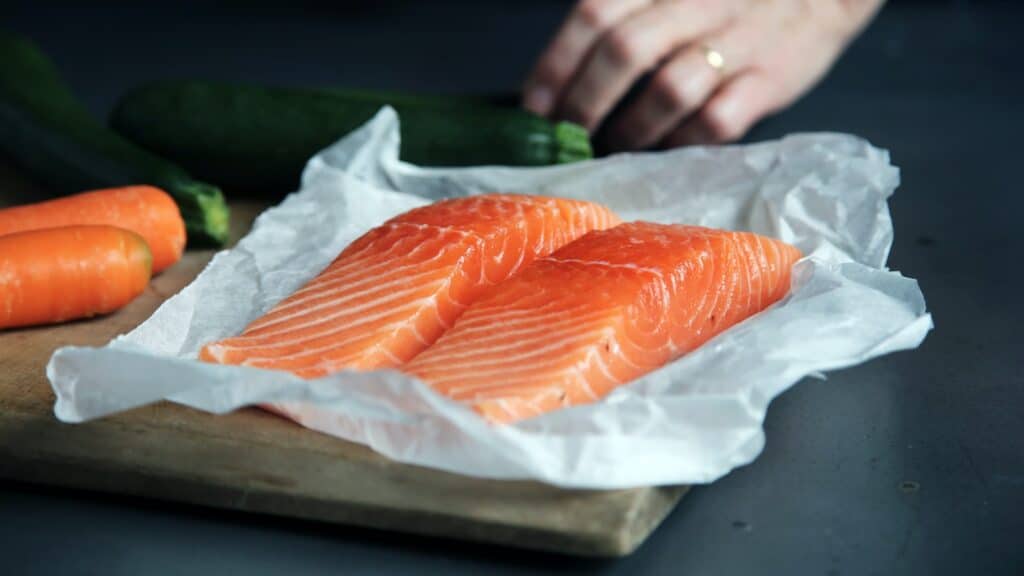Ever wondered if Can dogs have tuna? We’re here to talk about it! Tuna can be tasty for dogs, but we need to be careful about how much they have. We want our furry friends to stay healthy.
Did you know some dogs can be allergic to tuna? But no worries, we’ll chat about that too, and make sure everything is safe for your pup.
And if you’re looking for cool ways to add tuna to your dog’s food, we’ve got some yummy recipes! But first, let’s talk about tunas—they’re super fast swimmers, zooming up to 75 kilometers per hour!
Enough with the fishy facts, let’s find out if dogs can eat tuna.
Table of Contents
Read Also: Can dogs have lemon? Are lemons safe for dogs?

Can dogs have tuna? Everything you need to know
Tuna is a good thing to add to your dog’s food because it has omega-3 fatty acids that make their skin and fur healthy. But remember, give it in small amounts so they don’t get too much mercury.
Always cook tuna well to make sure there are no germs. Canned tuna is okay if it’s in water or its juice, not oil. There’s also special dog food with tuna that can be good for your dog.
Some dogs might be allergic to tuna, so watch them the first time they try it. Tuna helps your dog’s immune system and can make them less swollen.
- You can be creative and mix tuna into your dog’s meals. How about trying homemade tuna oatmeal cookies or tuna sweet potato cookies? Your dog will enjoy the tasty tuna!
Where does tuna come from origin and habitat?
Tuna is a yummy fish enjoyed by people and dogs for its tasty flavor and lots of nutrients. But where does tuna come from, and where does it like to live? Well, tuna is a seafish that hangs out in warm, open oceans all over the world. They’re known for swimming fast and often travel in big groups.
These fish can live pretty deep underwater, up to 400 meters! They munch on smaller fish, squid, and crustaceans. Tunas are part of the mackerel fish family, and you can find them in many dishes worldwide, either fresh or canned. If you want fresh tuna for your dog, make sure it’s good quality and safe for them.
Remember, too much tuna isn’t good for dogs because it has a lot of mercury. So, it’s best to give it as an occasional treat or side dish, not as the main part of your dog’s meals.
In a nutshell, tuna is a tasty and healthy treat for your dog, as long as you share it occasionally and choose good-quality tuna. Always think about what your dog needs, and if you ever have questions, talk to your vet!

Natural support from tuna
Tuna is like a natural superhero for dogs! It’s packed with omega-3 fatty acids that do amazing things for your furry friend, like keeping their skin and fur healthy, supporting their immune system, and helping with inflammation. Tuna can even be a hero for their joints and hearts!
Not only that, tuna gives dogs important proteins that help them build and keep strong muscles. But here’s the important part: too much tuna is not good because it has something called mercury that can hurt dogs.
So, it’s best to give tuna as a special treat or mix it into a balanced diet in the right amount. When picking tuna for dogs, choose ones without extra spices or salt. And never give them raw tuna—it might have yucky bacteria.
If you’re thinking about dog food with tuna, go for high-quality stuff that matches what your dog needs. In a nutshell, tuna is a healthy addition to doggy meals, but remember, it’s all about balance. Always talk to your vet before adding new foods to your dog’s menu to make sure it’s just right for them!
How much tuna can dogs eat?
Tuna is super tasty for us, but can dogs have it too? Yep, they can! Tuna helps keep dogs healthy, but how much is just right?
Well, it depends on how big your dog is. As a general rule, about 10% of their food can be tuna. But be careful! Cut it into small pieces, and make sure there are no bones.
But here’s the thing: too much tuna isn’t good because it has something called mercury. So, dogs should only have tuna two to three times a week.
Don’t use oily or salty tuna, and go for fresh or canned in water or juice. You can even serve it raw or cooked. And guess what? Dogs can enjoy other fish like salmon or herring too!
In a nutshell, tuna can be a yummy and healthy part of your dog’s meals, but keep it in check. If you’re thinking of changing your dog’s food, always chat with your vet first!
Can my dog eat tuna? Important information and recommendations!
- You can use tuna as a natural supplement to your dog’s diet.
- Be careful how much tuna you give your dog and stick to the recommended amount.
- Avoid potential risks by choosing canned tuna that is safe for dogs.
Are there any risks of feeding tuna to dogs?
Feeding tuna to dogs is cool, but there are some things to watch out for. Tuna has awesome stuff like omega-3 fatty acids, vitamin D, and proteins that are good for dogs. But, it’s crucial to get the right amount and prepare it safely. Raw tuna can have yucky bacteria or parasites, so cooking it is smart.
Now, about mercury—it’s in tuna, and too much is not good for dogs. So, just a bit of tuna is safe. The experts say around 25 grams per 5 kilograms of your dog’s weight each week is okay.
When picking tuna, go for high-quality ones without extra spices or salt. Special dog food with tuna is also a good option, making sure your dog gets all they need. But remember, tuna is like a special treat or extra, not the main meal. And when in doubt, talk to your vet to make sure your dog gets a healthy diet.
If you’re curious about other fish dogs can eat, check out our article on “Can dogs eat salmon” for all the details.

Raw or cooked tuna for dogs
Dogs enjoy tuna, but the big question is: should they have it raw or cooked? Each has its pros and cons. Raw tuna is full of good things like omega-3 fatty acids and proteins that make your dog’s skin, fur, and joints healthy. But, there’s a risk of yucky bacteria and parasites, so make sure to get it from a good source and wash it well.
Cooked tuna is safer because the heat kills most bacteria, but some nutrients go away during cooking. Still, it’s a great protein source for dogs. You can even mix both raw and cooked tuna to give your dog the best of both worlds. Just remember, it’s like a special extra, not the main meal.
Think about your dog’s taste and health, and it might be a good idea to ask your vet for advice. They’ll help you decide what’s best for your furry friend!
Nutrients and Benefits of Tuna for Dogs – Table
| nutrient | Amount per 100g tuna | Benefits for dogs |
|---|---|---|
| Protein | 26 g | Supports muscle building and tissue repair. |
| Omega-3 fatty acids | 2,2 g | Anti-inflammatory effect, promotes skin and coat health. |
| Vitamin D | 4,1 µg | Supports the absorption of calcium and phosphorus for strong bones and teeth. |
| To demand | 1,3 mg | Helps in the formation of red blood cells and promotes oxygen transport in the body. |
| Magnesium | 34 mg | Important for muscle and nerve function as well as for energy metabolism. |
| Potassium | 330 mg | Supports heart health and regulates fluid balance in the body. |
| Zink | 1 mg | Promotes wound healing and strengthens the immune system. |
| Vitamin B12 | 1,8 µg | Important for the formation of red blood cells and the function of the nervous system. |
Canned Tuna: Which Options Are Safe?
When it comes to giving your dog canned tuna, safety is key! Not all options on the market are good for our furry friends. Before sharing canned tuna with your dog, check that it’s marinated in water or juice—avoid the ones in oil because they can upset your dog’s stomach. Also, make sure it’s unsalted, as too much salt isn’t healthy for them.
When buying tuna, go for sustainably caught ones. This means they come from eco-friendly sources and don’t have harmful chemicals. Rinse the tuna well to lower the sodium content.
You can treat your dog with canned tuna or add it to their regular meals. It’s safe as long as you pick the right products and keep them in check. Always chat with your vet before adding tuna to your dog’s menu to be sure there are no risks or allergies.
So, if you want to give your dog a tasty change, canned tuna can be a good idea. Just remember moderation and the right choices keep your dog happy and healthy.
Dog food with tuna: A good option?
When it comes to giving our furry friends the best nutrition, dog owners often want the top-notch stuff. Tuna is a popular choice because it’s not just tasty; it can also bring health benefits.
So, is dog food with tuna a good idea? Absolutely! Dog food with tuna can be a great choice to fulfill your dog’s nutritional needs.
Tuna is loaded with omega-3 fatty acids, which do wonders for your dog’s skin, and coat, and even help with inflammation and boost the immune system. But here’s the trick: make sure the dog food has high-quality ingredients and no artificial additives or preservatives. Also, check that the tuna is in water or its juice, not oil—too much oil can upset your dog’s tummy.
When you switch your dog’s food, do it slowly to avoid tummy issues. Start with a bit and increase it over a few days.
In the end, dog food with tuna can add variety and healthiness to your dog’s diet. But, as always, talk to your vet to be sure it’s the right choice for your dog.
By the way, did you know that dogs have super sniffers and can even smell tuna underwater?

Can dogs have tuna allergies?
Tuna is a tasty treat for many dogs, but can some be allergic to it? Usually, tuna is safe and doesn’t cause allergies for most dogs. But, like with anything, there can be exceptions, and some dogs might actually be allergic to tuna.
If your dog is allergic, it shows up kinda like other food allergies—think skin rashes, itching, tummy problems, or trouble breathing. If you notice these after your dog eats tuna, it’s best to see the vet to check for an allergy.
Assuming your dog is allergy-free, tuna can be a healthy boost to their diet. It’s got omega-3 fatty acids that keep their skin and coat looking good, plus proteins that build and maintain muscles.
But, here’s the key: tuna should be a sometimes snack, not an everyday thing. Too much can lead to too much mercury, and that’s not good for your dog’s health. Generally, though, tuna is a good choice for most dogs, as long as allergies aren’t an issue.
Keep an eye on how your dog reacts after tuna time, and if you ever worry, talk to your vet.
Health Benefits of Tuna for Dogs
Tuna isn’t just a yummy treat for us; it’s good for our furry friends too! It’s packed with omega-3 fatty acids that do wonders for dogs’ health—they reduce inflammation, boost the immune system, and keep the heart healthy.
Not only that, tuna has top-notch proteins that dogs need to build and fix tissues. It’s also loaded with vitamins and minerals like vitamin D, vitamin B12, potassium, and selenium, supporting your dog’s overall well-being.
But here’s the thing: too much tuna isn’t good. It has mercury, and an overdose of that can harm your dog. So, make tuna a special snack or add it to their balanced diet now and then.
Fresh, cooked tuna is the best pick because it has no added preservatives or salt. If you go for canned tuna, choose the one in water or its juice, without extra spices or oils. Overall, tuna can be a healthy and tasty part of your dog’s meals, but keep it in check and pick good-quality tuna. Your furry buddies will wag their tails in thanks!
If you’re curious about other foods that might be risky for dogs, check out our video to find out if tuna is on the list!
Conclusion
In general, tuna is a healthy addition to your dog’s diet, as it is rich in nutrients. But, it’s crucial to watch the quantity and make sure the tuna is bone-free and free of spices. Whether it’s canned or cooked, raw or in various forms, tuna can support your dog’s natural nutrition and health.
However, be cautious about mercury exposure, so keep the consumption moderate. If your dog has allergies, introduce tuna slowly. Other fish options are good for dogs.
All in all, tuna brings health benefits and can be added to your dog’s diet in creative ways. If you’re interested in learning more about the right nutrition for your dog, check out our other articles for helpful information.


